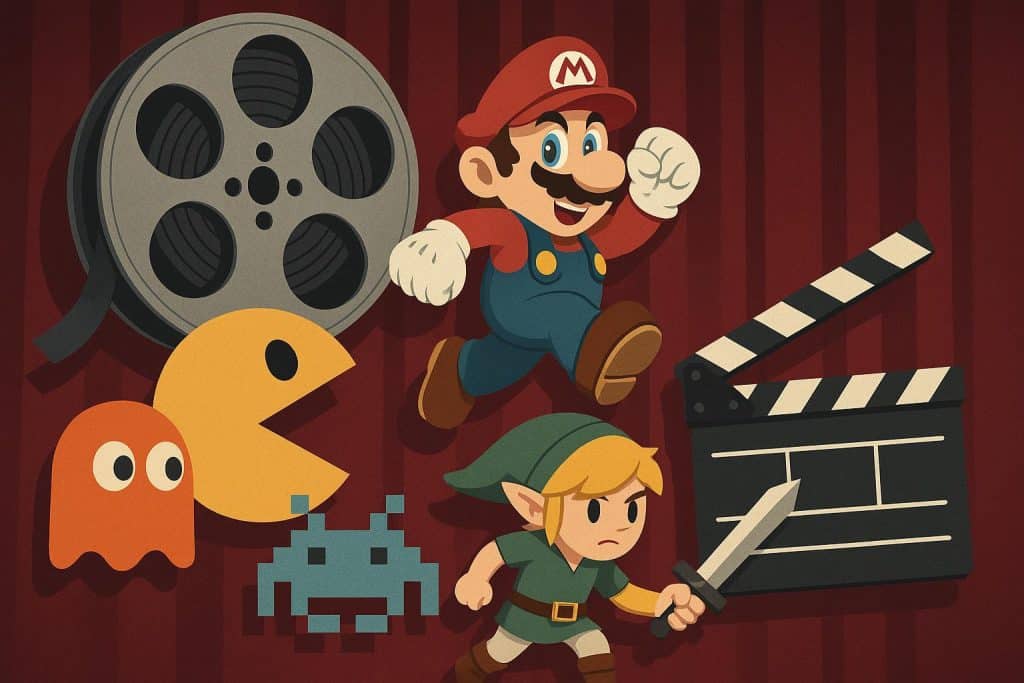There’s a moment in film when dice roll, cards flip, marbles spin, or a pawn moves forward: it’s the moment a game becomes the driving force of the narrative. Directors have long used green tables, chessboards, and consoles as devices of tension, ethical mirrors, or shortcuts to reveal character and conflict. In this feature, we revisit some of the most memorable appearances of games on the big screen — from casinos to pool halls, from chess clubs to board game adventures — and why they work so well on screen.
Roulette: fate and behind-the-scenes looks
When it comes to roulette in film, it’s impossible not to start with Casablanca: Rick, trying to save a young couple, “suggests” that the croupier spin the wheel to land on 22, turning a roll of chance into an act of mercy that defines the character better than a hundred lines of dialogue. The now-iconic scene shows how a game of pure luck can become a narrative tool to talk about ethics and sacrifice.
At the opposite end, Mike Hodges’ Croupier flips the camera’s point of view to the house’s side: we follow a young dealer (Clive Owen) through rules, procedures, and emotional distance that shield the professional from the chaos of the gaming floor. It’s not the thrill of betting, but the anatomy of the job that makes the film hypnotic.
Expanding the lens, Martin Scorsese’s Casino uses roulette, craps, and blackjack as the choreography of power: games and tables become an ecosystem where control, risk, and spectacle turn into a visual language.
In many films, directors have chosen roulette games to build moments of suspense and pathos, precisely because their unpredictability makes every scene instantly readable and charged with tension.
Poker: revealed psychologies and modern mythologies
Casino Royale (2006) replaces Bond’s classic baccarat with Texas hold ’em and transforms it into a duel of nerves: rhythm, editing, and direction package the rules of the table into an action set piece where every card is a revelation of character, not just of score.
With Rounders (1998), poker becomes gritty urban realism: underground clubs, private games, and “tells” create the lexicon of a shadowy New York. It’s no coincidence that many professional players acknowledged the film’s rare attention to settings and dynamics, inspired by the legendary Mayfair Club.
Years later, Aaron Sorkin’s Molly’s Game sheds light on the organizational side of high-stakes poker: invitations, guest lists, rake, legal frameworks, and player management. The focus is on the power (and cost) of orchestrating a private ecosystem living on the edge of legality, more than on the hands themselves.
Blackjack: math, teamwork and…Hollywood
When Hollywood tackles card counting, the most famous result is 21: inspired by the true story of the MIT Blackjack Team, the film puts signals, scripts, and logistics on screen, showing a game that, in reality, required discipline and cooperation more than daring. Both chronicles and the real protagonists often recalled how much the screenplay dramatized the events, while still drawing from authentic elements.
Billiards/pool: the pride of the champion and the school of character
The Hustler (1961) helped revive pool culture in the United States, portraying talent as both a curse and redemption through the clash with “Minnesota Fats.” The table is not just an arena of skill but a moral mirror where victory comes only with self-awareness.
Twenty years later, The Color of Money (1986) brings “Fast Eddie” back into play and updates the myth: Newman wins the Oscar and Scorsese turns trick shots into choreography, making pool a generational rite of passage alongside the fiery young Tom Cruise.
Chess: strategy, identity, and redemption
When the chessboard appears on screen, cinema tends to talk about growth and identity. Searching for Bobby Fischer (1993) is a coming-of-age story where Josh Waitzkin’s talent collides with pressure and role models to follow or surpass.
Queen of Katwe (2016) tells the true story of Phiona Mutesi, from the Katwe slum to international tournaments: checkmate becomes a form of empowerment, in one of the brightest portrayals of the relationship between play and social opportunity.
On the historical-biographical side, Pawn Sacrifice retraces the 1972 Fischer-Spassky match, using chess as a battlefield of both psychology and geopolitics.
Mahjong: a conversation without words
In Crazy Rich Asians (2018), the climactic mahjong game is all symbolism: choice, cultural belonging, sacrifice. The mise-en-scène plays with table positions (the “East” seat) to make the subtext readable even for viewers unfamiliar with the rules. It’s a masterful example of how a game can “speak” on its own.
Board games (and beyond): from dice rolls to digital worlds
Jumanji (1995) places a board game at the heart of its story and makes it a portal: with every move, the game world invades reality. Its success spawned sequels and, in 2017, a spinoff that updated the concept into a video game, proving how cinema reflects the gaming languages of its time.
In WarGames (1983), the “game” is a military simulator: a teenager searching for new video games stumbles into the WOPR computer, triggering Cold War scenarios. The famous lesson “The only winning move is not to play” shows how cinema uses games to question ethics and technology.
Then there’s Tron (1982), which imagines a world inside a computer and went on to inspire a hugely successful arcade game: here, the relationship flips, with the film creating a game that became as culturally iconic as (if not more than) the movie itself.
